
The Mauritshuis is an art museum in The Hague, Netherlands. The museum houses the Royal Cabinet of Paintings which consists of 854 objects, mostly Dutch Golden Age paintings. The collections contains works by Johannes Vermeer, Rembrandt van Rijn, Jan Steen, Paulus Potter, Frans Hals, Jacob van Ruisdael, Hans Holbein the Younger, and others. Originally, the 17th century building was the residence of count John Maurice of Nassau. It is now the property of the government of the Netherlands and is listed in the top 100 Dutch heritage sites.

The Massacre of the Innocents is the subject of two paintings by Peter Paul Rubens depicting the episode of the biblical Massacre of the Innocents of Bethlehem, as related in the Gospel of Matthew (2:13-18). The first, measuring 142 x 182 cm, was painted after his return to his native Antwerp in 1608, following eight years spent in Italy.

Girl with a Pearl Earring is an oil painting by Dutch Golden Age painter Johannes Vermeer, dated c. 1665. Going by various names over the centuries, it became known by its present title towards the end of the 20th century after the earring worn by the girl portrayed there. The work has been in the collection of the Mauritshuis in The Hague since 1902 and has been the subject of various literary treatments. In 2006, the Dutch public selected it as the most beautiful painting in the Netherlands.
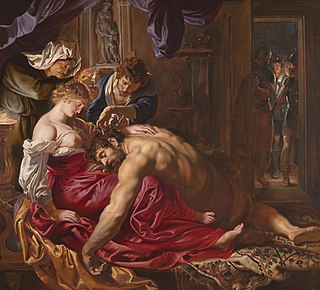
Samson and Delilah is a painting by the Flemish Baroque painter Peter Paul Rubens (1577–1640) which is displayed in the National Gallery. It dates from about 1609 to 1610.

The Soviet sale of Hermitage paintings in 1930 and 1931 resulted in the departure of some of the most valuable paintings from the collection of the State Hermitage Museum in Leningrad to Western museums. Several of the paintings had been in the Hermitage Collection since its creation by Empress Catherine the Great. About 250 paintings were sold, including masterpieces by Jan van Eyck, Titian, Rembrandt, Rubens, Raphael, and other important artists. Andrew Mellon donated the twenty-one paintings he purchased from the Hermitage to the United States government in 1937, which became the nucleus of the National Gallery of Art in Washington, D.C.
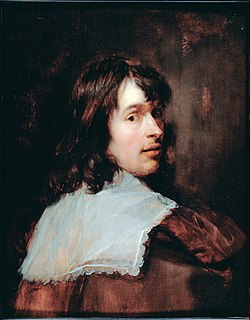
Jan Cossiers was a Flemish painter and draughtsman. Cossiers' earliest works were Caravaggesque genre works depicting low life scenes. Later in his career he painted mostly history and religious subjects as well as portraits. Cossiers was one of the leading painters in Antwerp after Rubens' death in 1640 and one of the most original colorists in 17th-century Flanders.
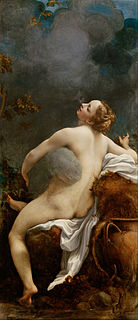
The Orleans Collection was a very important collection of over 500 paintings formed by Philippe d'Orléans, Duke of Orléans, mostly acquired between about 1700 and his death in 1723. Apart from the great royal-become-national collections of Europe it is arguably the greatest private collection of Western art, especially Italian, ever assembled, and probably the most famous, helped by the fact that most of the collection has been accessible to the public since it was formed, whether in Paris, or subsequently in London, Edinburgh and elsewhere.

Sir Peter Paul Rubens was a Flemish artist and diplomat from the Duchy of Brabant in the Southern Netherlands. He is considered the most influential artist of the Flemish Baroque tradition. Rubens's highly charged compositions reference erudite aspects of classical and Christian history. His unique and immensely popular Baroque style emphasized movement, colour, and sensuality, which followed the immediate, dramatic artistic style promoted in the Counter-Reformation. Rubens was a painter producing altarpieces, portraits, landscapes, and history paintings of mythological and allegorical subjects. He was also a prolific designer of cartoons for the Flemish tapestry workshops and of frontispieces for the publishers in Antwerp.
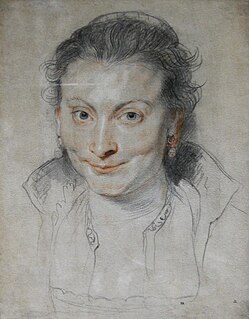
Isabella Brant,a portrait drawing, was executed in Antwerp around 1621, by Flemish artist and diplomat, Peter Paul Rubens (1577–1640). Brant (1591–1626) was Rubens' first wife and modelled for some of his portraits until her untimely death in 1626. The portrait is drawn in black and red chalk with white heightening on brown wash paper.
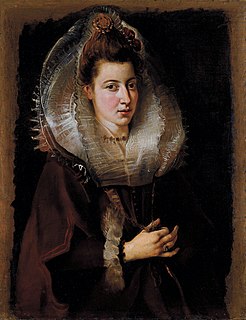
Portrait of a Young Woman is an unfinished painting of around 1603, attributed to Rubens. It may be connected with a commission from Vincenzo Gonzaga, Duke of Mantua mentioned in Rubens' letters, during the latter's time in Italy and Spain, to paint aristocratic Spanish ladies to add to the duke's 'gallery of beauties'. Its subject's name is unknown. Two red seals on its back place it in Venice early in the 19th century and then in the collection of Sir John Hanmer at Bettisfield Park in Wrexham by the 1840s.

The Madonna and Child with Saints Luke and Catherine of Alexandria, also known simply as Holy Conversation, is a painting by the Italian Renaissance master Titian. It is one of his several versions of the canonical image of the Madonna and Child.
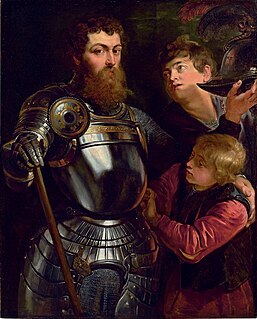
Portrait of a Commander or A Commander Being Dressed for Battle is a portrait of an unknown man in plate armour, normally attributed to Peter Paul Rubens. In July 2010 it was sold for £9 million by Christie's after Sotheby's turned it down, suspecting its authenticity as a Rubens. In December 2011, the portrait was placed on loan with the Metropolitan Museum of Art in New York.
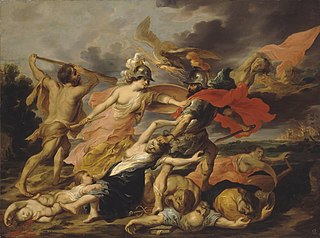
Victor Wolfvoet (II) or Victor Wolfvoet the Younger, was a Flemish art dealer and painter of history and allegorical paintings. His artistic output was heavily influenced by Peter Paul Rubens.

The Finding of Moses is a 1904 painting by the Anglo-Dutch artist Lawrence Alma-Tadema. It was one of his last major works before his death in 1912, but quickly fell out of favour; according to rumour, it was sold in the 1950s for its frame. After appreciation of Victorian painting was renewed towards the end of the 20th century, it was described in an auction catalogue in 1995 as "the undisputed masterpiece of [Alma-Tadema's] last decade, as well as a late flowering of the nineteenth-century's love-affair with Egypt". It was sold to a private collector at auction in 2010 for nearly US$36 million.

La Gommeuse[la ɡɔmøz] is a 1901 oil on canvas painting by the Spanish artist Pablo Picasso. It dates from his Blue Period and is noted for its caricature of Picasso's friend Pere Mañach painted on the reverse. Gommeuse was sexually charged slang of the time for café-concert singers and their songs. It was offered for sale ex the William I. Koch collection at a Sotheby's, New York, auction on 5 November 2015. The painting realized $67.5 million at the sale, a record for a Blue Period Picasso, placing the painting among the most expensive ever sold.

Minerva is a 1635 oil on canvas painting by Rembrandt, now in a Canadian private collection.

Brothel Scene or Scene in an Inn is a c.1658 oil on panel painting by the Dutch Golden Age painter Frans van Mieris. Since 29 January 1960 it has been in the collection of the Mauritshuis in The Hague.

Le Palais Ducal or The Doge's Palace is the name given to various oil paintings which depict the Doge's Palace made by Claude Monet during a visit to Venice in 1908.
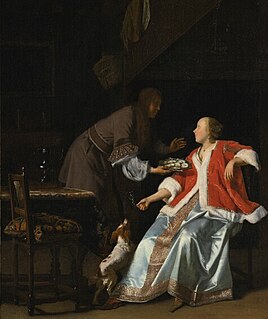
The Oyster Meal is an oil on canvas genre painting by the Dutch Golden Age artist Jacob Ochtervelt, dated to around 1664–65. It depicts a man offering a plate of oysters to a woman he is trying to seduce.



















